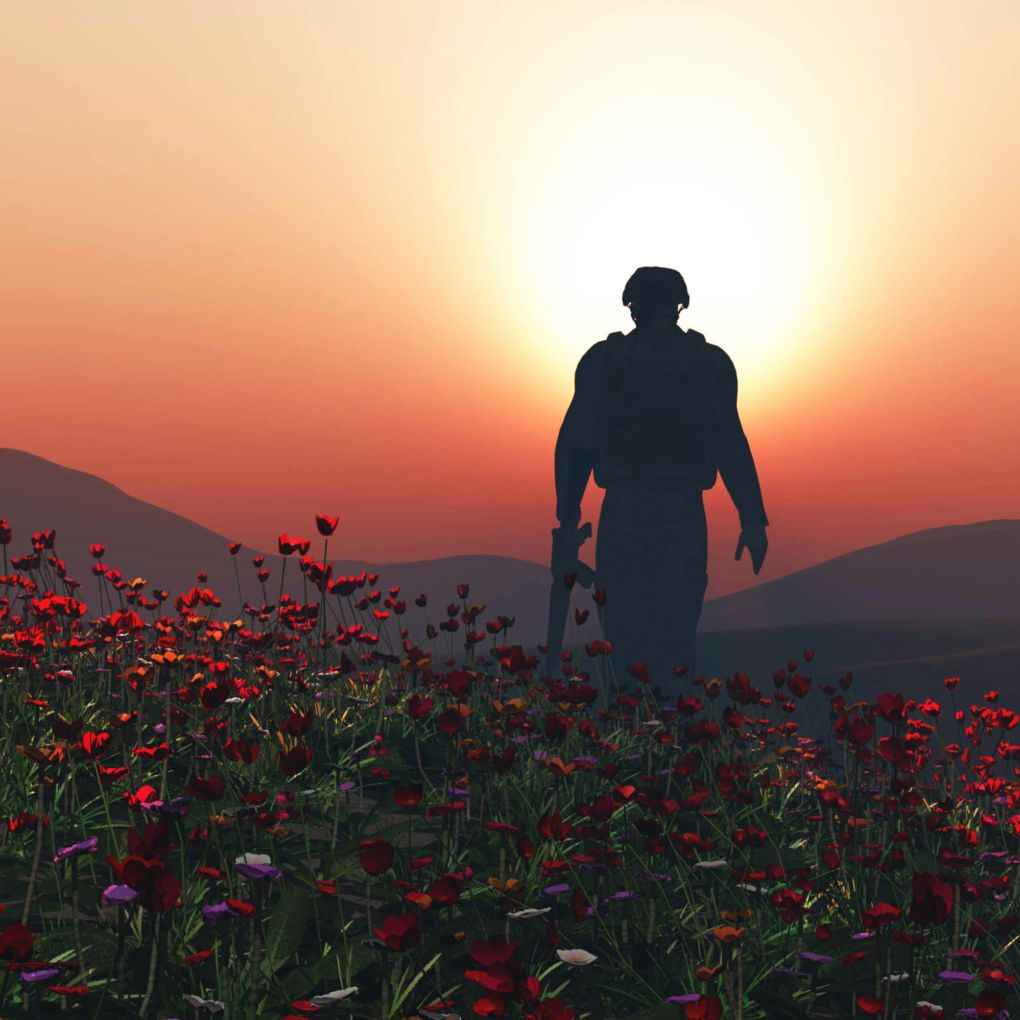Imagine it’s Memorial Day weekend. A man or woman in a military uniform sits at a folding table near a grocery store’s entrance. On the table rests a canister for donations that sports the logo of a veteran’s organization like the American Legion. If you donate, you’ll receive a red crepe-paper poppy with a green wire stem.
The poppy is a symbol of remembrance. You might tuck it into your pocket or wear it through the zipper pull of your jacket. Maybe you’ll wrap the wire stem around the top of your car’s rearview mirror, and when you glance at it, for a moment you’ll remember the millions who have died in military service.
Origin of the Poppy as a Symbol of Remembrance
Many of us recognize the poppy as a symbol of fallen troops. It reminds us to pause and reflect on those who lost their lives in military service. But why did the poppy come to symbolize war casualties?
How World War I Inspired “In Flanders Fields”
The intense battles of World War I (1914-1918) claimed the lives of nearly nine million soldiers and about 10 million civilians. They also ravaged the European landscape, destroying structures and tearing up meadows, forests, and farmland.
Amidst the ruins of northern France and Flanders (northern Belgium), poppies proliferated, dotting the ruined landscape with scarlet. The poppy is a vigorous and tenacious plant, which is why it’s sometimes classified as a weed. It may have flourished because of, not in spite of, the harsh conditions and lime-enriched soil created by the wartime rubble.
In 1915, Lieutenant Colonel John McCrae was inspired by the spring poppies after the Second Battle of Ypres. McCrae, a doctor, had volunteered to serve in the Canadian armed forces, where he became brigade surgeon for an artillery unit. No stranger to wartime carnage, McCrae penned a poem that would soon become famous, “In Flanders Fields.”
“In Flanders Fields, the poppies blow / Between the crosses, row on row,” McCrae’s poem begins. By the time McRae died of pneumonia and meningitis in 1918, it had become one of the most popular and oft-quoted works of literature associated with The Great War.
Written from the point of view of fallen soldiers, “In Flanders Fields” ends:
If ye break faith with us who die
from “In Flanders Fields,” Lieutenant Colonel John McCrae, 1915
We shall not sleep, though poppies grow
In Flanders fields.
How the Poppy Became a U.S. Symbol of War Casualties

In the United States, University of Georgia professor Moïna Michael wrote the poem “We Shall Keep Faith” in response to “In Flanders Fields.” In 1918, she began wearing a red poppy in honor of World War I’s fallen. She began to make and sell poppies to raise money for veterans and campaigned to have the poppy recognized as a symbol of war casualties.
By 1920, Michael succeeded in getting Georgia’s branch of the American Legion to adopt the poppy as its symbol. Soon after, the National American Legion voted to recognize the poppy as its official emblem of remembrance.
But it was the Veterans of Foreign Wars (VFW) that organized the first nationwide distribution of poppies on Memorial Day in 1922. The VFW adopted the poppy as its official symbol of remembrance soon after. Today, at-risk and disabled veterans in VA hospitals produce the VFW’s poppies.
The Poppy’s Significance in Europe
In France, Anna Guérin was similarly inspired by McCrae’s poem and the ubiquitous poppy. She organized large drives to make and sell silk poppies to raise funds for war widows, orphans, and veterans, and to help fund post-war restoration efforts. She founded a worldwide Poppy Days fundraising effort. Poppy-making factories arose and often employed disabled veterans, who crafted silk and paper blooms.
What Holidays Are Poppies Associated With?
In the United States, the poppy is associated with Memorial Day. Memorial Day is a U.S. federal holiday that traditionally occurred on May 30 but is now observed on the last Monday in May.
Over the years, we’ve come to associate Memorial Day with many things — parades, barbecues, and the beginning of summer among them. But the true meaning of Memorial Day lies in the final lines “In Flanders Fields,” which encourage us to not “break faith” with those who have died by taking time to remember them.
How the Poppy Is Used in Europe
In Europe, the poppy remains an enduring symbol of fallen troops, but it’s connected to a different holiday — Remembrance Day or Armistice Day. The holiday falls on November 11th and commemorates the anniversary of the 1918 armistice, an agreement between nations to cease hostilities.
In the U.S. November 11 marks Veteran’s Day, a day to honor all those who served, living or dead. Americans don’t traditionally associate Veteran’s Day with the poppy.
Wear Your Poppy on Memorial Day
If you live in the U.S., the approach of Memorial Day means more than a day off to spend with family and friends. Memorial Day is, above all, a day of solemn remembrance to honor those who gave their lives in military service.
The poppy is an enduring symbol of their sacrifice.
References:
- “The WWI Origins of the Poppy as a Remembrance Symbol,” History
- “8 Battlefield Poets of World War I,” History
- “The Poppy Story,” American Legion
- “World War 1: Killed, Wounded, and Missing,” Britannica
- “Buddy Poppy,” VFW


